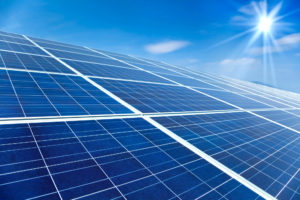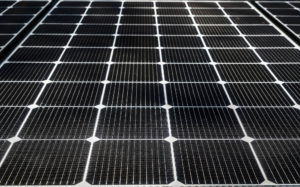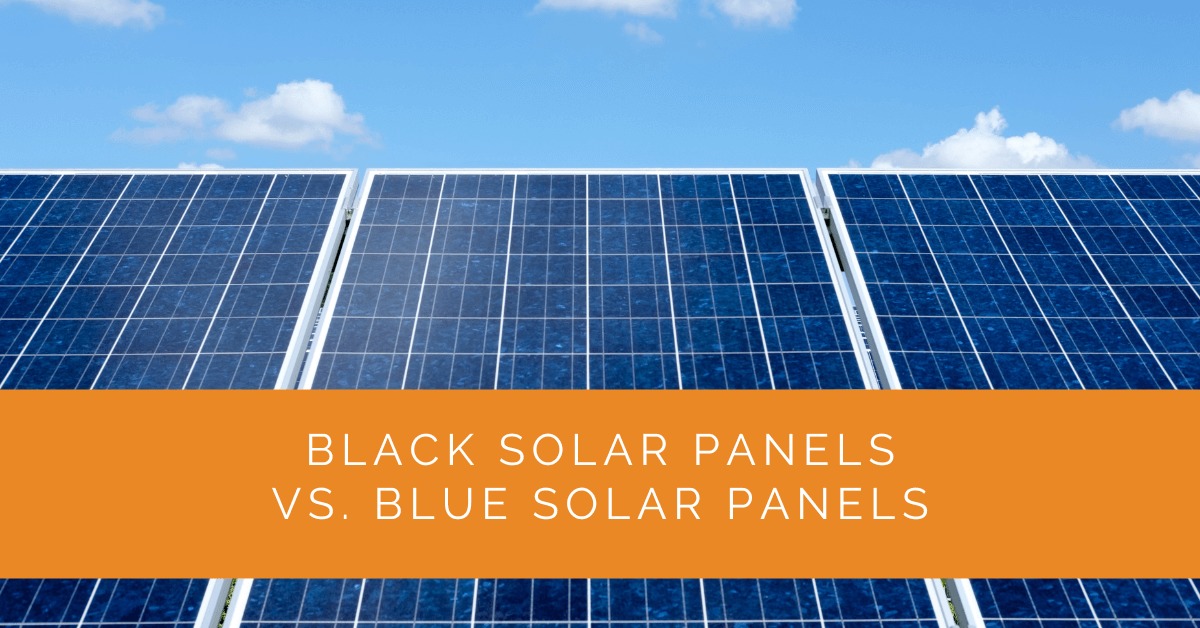As the popularity of solar energy continues to rise, it’s essential to understand the differences between black and blue solar panels. In this in-depth article, we’ll delve into each type’s composition, advantages, and potential drawbacks, helping you make an informed decision for your solar system. Let’s explore the fascinating world of black and blue solar panels!
Contents
- 1 Key Takeaways
- 2 Understanding Black Solar Panels
- 3 Understanding Blue Solar Panels
- 4 Black vs. Blue Solar Panels: Factors to Consider
- 5 Case Study: Selecting the Right Solar Panels for a Residential Installation
- 6 Expert Insights From Our Solar Panel Installers About Black Solar Panels vs. Blue Solar Panels
- 7 Experience Solar Excellence with Us!
- 8 Conclusion
Key Takeaways
- Black solar panels, made of monocrystalline silicon, offer higher efficiency and a sleek appearance, while blue solar panels, composed of polycrystalline silicon, provide cost-effectiveness and better performance in low-light conditions.
- Consider factors such as efficiency, aesthetics, and cost when choosing between black and blue solar panels, considering your location, available sunlight, and budget constraints.
- Consulting with solar professionals and considering expert advice can help you make an informed decision based on your specific needs and preferences, ultimately maximizing the benefits of solar energy for your system.
Understanding Black Solar Panels
Black solar panels, primarily composed of monocrystalline silicon, offer unique characteristics and benefits that set them apart from other types. Let’s dive deeper into the details of black solar panels:
Composition and Structure
Black panels are made using monocrystalline solar cells crafted from a single, high-purity silicon crystal. The manufacturing process involves carefully growing a single crystal ingot and then slicing it into thin wafers. This method ensures the highest quality and efficiency for the resulting solar panels.
Advantages of Black Solar Panels
Black solar panels come with several advantages that make them a popular choice for many homeowners and businesses:
- Higher Efficiency: Monocrystalline solar cells are renowned for their superior efficiency in converting sunlight into electricity. With their high-quality monocrystalline cells, black panels excel at capturing and utilizing solar energy effectively. This high efficiency makes them ideal for installations with limited space or where maximizing energy production is a priority.
- Aesthetic Appeal: Black solar panels offer a sleek and uniform appearance that blends seamlessly with various roof types and architectural styles. The black color provides a visually pleasing aesthetic that many homeowners find appealing.
Potential Cons of Black Solar Panels
While black solar panels have numerous benefits, it’s important to consider a few potential drawbacks:
- Higher Cost: The manufacturing process involved in creating monocrystalline solar cells is more complex and results in higher production costs than other solar panels. As a result, black panels are typically more expensive. However, it’s worth noting that the long-term energy savings and efficiency gains may offset the initial investment over time.
- Performance in High-Temperature Conditions: Black solar panels have a higher tendency to absorb and retain heat due to their color and composition. This can slightly impact their performance in high-temperature environments, leading to a reduction in efficiency. However, advancements in panel design and technology have mitigated this issue to a great extent.

Understanding Blue Solar Panels
Blue solar panels, commonly composed of polycrystalline silicon, offer their characteristics and advantages. Let’s delve deeper into the details of blue solar panels:
Composition and Structure
Blue panels are created using polycrystalline silicon cells, which are formed by pouring molten silicon into molds to create multiple crystals. This manufacturing process results in panels with a characteristic blue color due to the random orientation of the silicon crystals.
Advantages of Blue Solar Panels
Blue solar panels provide several advantages that make them a popular choice for certain applications:
- Lower Manufacturing Costs: The production process for polycrystalline solar panels is simpler and generates less waste than the manufacturing process for monocrystalline panels. This efficiency leads to lower production costs, making blue panels a more cost-effective option for those on a tighter budget.
- Better Performance in Low-Light Conditions: Blue solar panels exhibit a higher tolerance for low-light conditions, making them suitable for regions with less sunlight or installations with partial shading. They can generate electricity even under cloudy or overcast skies, making them a reliable choice for locations with variable weather patterns.
Potential Cons of Blue Solar Panels
While blue solar panels offer several advantages, there are some potential drawbacks to consider:
- Slightly Lower Efficiency: Polycrystalline solar cells are slightly less efficient than their monocrystalline counterparts. The random orientation of silicon crystals in blue panels can result in slightly lower efficiency levels. However, it’s important to note that technological advancements have significantly narrowed the efficiency gap between the two types of panels.
- Appearance Variability: Due to the random orientation of the silicon crystals, blue solar panels may have a less uniform appearance compared to sleek and consistent black panels. Some homeowners prefer the unique blue color, while others may find it less visually appealing. Consider your aesthetic preferences and the overall look you desire for your solar system.

Black vs. Blue Solar Panels: Factors to Consider
When choosing between black and blue solar panels, it’s crucial to consider several factors to make an informed decision. Let’s explore the key factors that can influence your choice:
Efficiency and Performance
Monocrystalline solar panels, such as black panels, generally offer higher efficiency, especially in direct sunlight. They excel at converting sunlight into electricity and are highly efficient in limited spaces. On the other hand, blue panels, with their polycrystalline cells, perform better in low-light conditions and are more tolerant of partial shading. Consider your location, the amount of sunlight you receive, and any potential shading issues to determine which type best suits your energy needs.
Aesthetic Considerations
The appearance of your solar panels can be an important consideration, particularly if visual harmony and architectural integration are important to you. Black panels provide a sleek, uniform look that seamlessly integrates with different roof types and colors. The black color is often preferred for its sophisticated appearance. Conversely, blue panels offer a distinct blue hue that may be desired in certain settings or for those seeking a unique visual aesthetic. Consider the visual impact and compatibility with your property when making your decision.
Cost and Affordability
Cost is a significant factor when considering any solar panel installation. Black panels, made of monocrystalline cells and involving a more complex manufacturing process, generally come with a higher upfront cost. However, their higher efficiency and longer lifespan can result in long-term energy savings, potentially offsetting the initial investment. Blue panels, with their simpler manufacturing process and lower production costs, provide a more affordable option for those with budget constraints. Evaluate your budget, long-term financial goals, and expected return on investment to find the right balance between cost and performance.
It’s important to note that black and blue solar panels are reliable and effective in harnessing solar energy. The choice ultimately depends on your specific requirements, preferences, and budget. Consulting with solar professionals and considering expert advice can provide valuable insights tailored to your unique circumstances.
Case Study: Selecting the Right Solar Panels for a Residential Installation
Background
Solar Panels Network USA recently worked with a homeowner who was interested in installing a solar energy system on their property. The client was unsure whether to choose black monocrystalline panels or blue polycrystalline panels. Our goal was to help them make an informed decision based on their specific needs and preferences.
Project Overview
The client’s primary concerns were efficiency, cost, and aesthetic appeal. They wanted a solar system that would provide maximum energy output while complementing the visual appearance of their home. Our task was to evaluate both types of panels and recommend the best option for their situation.
Implementation
The project began with a comprehensive assessment of the client’s energy needs, budget, and aesthetic preferences.
- Energy Needs Assessment: We conducted an energy audit to determine the client’s average energy consumption. This helped us understand the required capacity of the solar system.
- Budget Analysis: The client had a moderate budget and was looking for a balance between cost and efficiency. We provided detailed cost comparisons for both black and blue panels, including initial investment and long-term savings.
- Aesthetic Evaluation: The client was particularly concerned about how the panels would look on their roof. We presented visual simulations of both black and blue panels installed on their home to help them visualize the final appearance.
- Technical Comparison: We explained the technical differences between black monocrystalline panels and blue polycrystalline panels. This included discussions on efficiency, performance in low-light conditions, and potential impacts of high temperatures.
Results
After thorough discussions and evaluations, the client decided to install black monocrystalline panels. Key reasons for this decision included:
- Higher Efficiency: The client valued the higher efficiency of monocrystalline panels, which provided more energy output per square foot, crucial for their limited roof space.
- Aesthetic Appeal: The sleek, uniform appearance of black panels matched their aesthetic preferences, blending seamlessly with their roof.
- Long-Term Savings: Although the initial cost was higher, the efficiency and durability of monocrystalline panels promised greater long-term savings on energy bills.
Summary
This case study highlights the importance of considering multiple factors when choosing between black and blue solar panels. By assessing energy needs, budget, and aesthetic preferences, we were able to recommend a solution that met the client’s goals. The black monocrystalline panels provided the right balance of efficiency, appearance, and long-term value.
At Solar Panels Network USA, we pride ourselves on helping clients make informed decisions about their solar installations. Our expertise and personalized approach ensure that each solar system is tailored to meet specific needs, maximizing the benefits of renewable energy.
Expert Insights From Our Solar Panel Installers About Black Solar Panels vs. Blue Solar Panels
As a senior solar installer, I’ve found that black solar panels, with their monocrystalline silicon composition, offer superior efficiency and a sleek appearance. They are ideal for homeowners looking to maximize energy production in limited spaces.
Senior Solar Installer
Blue solar panels, made of polycrystalline silicon, are a cost-effective option, especially for larger installations. They perform well in low-light conditions and are a reliable choice for regions with variable weather patterns.
Lead Solar Technician
Choosing between black and blue solar panels ultimately depends on your specific needs and budget. Both types have their advantages, and consulting with solar professionals can help you make an informed decision that maximizes the benefits of your solar installation.
Chief Solar Engineer
Experience Solar Excellence with Us!
Trust in Solar Panels Network USA, where our seasoned experts deliver top-quality solar solutions for homes and businesses nationwide. With a legacy of countless successful installations and a commitment to sustainable energy, we’re your reliable partner in the solar journey. Ready for a brighter, eco-friendly future? Call us now at (855) 427-0058 and harness the power of the sun!
Conclusion
The decision between black and blue solar panels involves weighing efficiency, aesthetics, and cost. Black panels offer higher efficiency and a sleek appearance but come at a higher cost. Blue panels provide cost-effectiveness and perform well in lower-light conditions. Assess your priorities, consult with experts, and weigh the pros and cons to determine which type of solar panel best fits your solar system. By making an informed decision, you can maximize the benefits of solar energy and contribute to a sustainable future.
About the Author
Solar Panels Network USA stands at the forefront of solar energy solutions, driven by a team of seasoned solar engineers and energy consultants. With over decades of experience in delivering high-quality solar installations and maintenance, we are committed to promoting sustainable energy through customer-centric, tailored solutions. Our articles reflect this commitment, crafted collaboratively by experts to provide accurate, up-to-date insights into solar technology, ensuring our readers are well-informed and empowered in their solar energy decisions.

